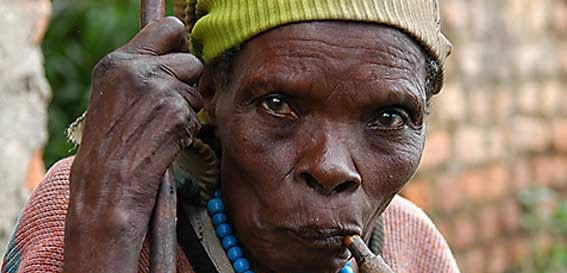
The Banyarwanda or Bafumbira are found in the old districts of Ankole and Kigezi bordering Rwanda. They have, however, spread to many parts of Uganda. Ethically, they are the same as the Banyarwanda of Rwanda. Those who inhabit Kisoro District in the extreme southwest of Uganda are called Bafumbira. This is the only district that is inhabited almost exclusively by Banyarwanda. To their west, is Zaire and to their south id Rwanda. Their land is mountainous and cool. Bafumbira was part of Rwanda until the boundary adjustments of 1910.The actual inhabitants of Bafumbira, in descending order of numerical superiority, are the Bahuutu, the Batutsi and the Batwa. Essentially, they are Banyarwanda and they speak Kinyarwanda.
The Batwa are said to have been the original inhabitants of Bufumbira and they are closely related to the Bambuti of Mt. Rwenzori. The Bahuutu are said to have been the second group to arrive in Bufumbira. Then came the Batutsi before A.D 1500.
Origins.
The Batwa do not have traditions of early migration from anywhere. They are believed to have been the earliest inhabitants of East Africa together with the Bambuti of Mt. Rwenzori and Ndorobo of Kenya. To date they do not lead a permanent, settled life. The Bahuutu are Bantu and, like other Bantu, they are believed to have originated from the Congo region of Central Africa around A>D 1000. They are said to have entered Rwanda from northeast.
The Origin of Batutsi is, however, mythical. One theory says that they originated from Karagwe in northern Tanzania. Another very controversial one is the “Hamitic myth”. This theory has it that the Batutsi are not indigenous to East Africa. And that their original homeland might have been either Somalis or Ethiopia or Egypt. This theory is based, among other things on the fact that the Batutsi tend to resemble the Somali and Galla.
Social-set-up
The Batwa were a minority in Bufumbira and other Banyarwanda communities. They were the most scorned, mainly because their culture was very little understood. It is said that mo one ever saw a Mutwa‘s grave; no one knew when and how the Batwa organized their wedding ceremonies. Their incessant begging from the Bahuutu and Batutsi increased the scorn and disrespect directed at the Batwa. Those Batwa who lived in and around Chunya Bamboo forest reserve were experts at shooting with bows and arrows. They lived by hunting and gathering, eating and not only what they hunted and gathered abut also what the Bahuutu and the Batutsi neglected. They were also reputed mutton eaters.
The cultures of Bahuutu and Batutsi were similar. Like the majority of Bahuutu, the Batutsi did nit eat sheep and chicken. These they gave the Batwa. Besides, the Bahuutu and Batutsi women were not supposed to eat goat meat.
Marriage
Compared to the Batwa, and Bahuutu, the Batutsi married at a latter age. Although there seemed to be no taboos against marriage relationships, intermarriages between the Batwa, Bahuutu and Bahima were rare.
Among the Bahuutu and Batutsi, intermarriages between close relatives were prohibited on the claim that this connection would render the resulting offspring weal and vulnerable to spiritual attacks. Among the Batutsi, boys were usually pressed to marry even before they were ready. The girls were closely watched by their mothers and aunts. Virginity was highly prized. Premarital pregnancies were unwanted. A girl would be thrown into the forest and left to the mercy of wild animals if she conceived before marriage.
Formerly, parents would arrange marriages for their children. But there was also what was known as Gufata or Gaturura. Gafuta was an acceptable forced marriage in which a boy would conspire to and carry away a girl by force to become his wife. Among the Bahuutu, there was also what was known as ukwijana. This was a pre –arranged marriage in which the girl would sneak away from her parents and go to a boy’s home to get married. This occurred whenever a girl had a pre-marital pregnancy. Both Gufuta and ukwijana were socially accepted but not praise worthy.
Bride wealth was paid in the form of cows and goats. If a girl was forced into marriage, exorbitant bride wealth was paid. On the other hand, if a girl went to the boy’s home to get married, the bride wealth depended on how the girl went there. If it was the girl who decided to go, bride wealth would be small, but if it was the boy who wooed, it would be exorbitant. Thereafter, wedding arrangements would be entered into. On the wedding day, local sorghum beer and banana beer were served. The wedding celebrations took place at night and carried on into the morning hours.
On wedding days, traditional dances were performed. The Women would ululate while men sang and recited great historical events. They danced in pairs. The men would also jump. The musical instruments were drums and harps. Clapping was a common feature for all the groups. The Batwa were renowned harp players while the Bahuutu, llike the Bakiga, played the zither. Among the Batutsi the girls sang and danced in pairs while men danced in groups usually of more than ten people, called intore.
Polygamy was an acceptable practice. Not only did it increase the man’s status, but it also increase the family size. “Being monogamous was like marring one’s mother”, so they said. Divorce was also acceptable and could occur in any of the following instances; drunkenness, ill-treatment, adultery, gluttony, refusal or inability to offer sex and several other undesirable instances.
Economy
The economy of the Batwa was quite simple. They depended on hunting and gathering. They valued land least for they did not dig. They would get grains and beer from the Bahuutu and the Batutsi in exchange for wild animal skins, trophies, bows and arrows. Some Batwa would just live by begging. Their huts were as simple as those of the Bambuti. They used to wear a simple skin to cover their private parts. Batwa were, and continue to be, good at basketry and pottery.
Among the Bahuutu and the Batutsi, the ownership of a Mutwa was a sign of wealthy and security. Among the Bahuutu and the Batutsi, cattle was the main economic index. For this reason, the Batutsi were most respected because they had many herds of cattle. People did not have individual ownership of land because all the land belonged to the King. An individual could dig or graze cattle on any piece of land within reach of his home.
For digging, they used a booked widen hoe. The main crops included sorghum, peas and beans. The society had iron –smiths who manufactured hoes, knives and other implements on a small scale. To harvest sorghum, they used a suckle, umuhoro. Men cut the sorghum down and women used iron knives, indiga, to cut the sorghum form the stems. The produce was stored in bamboo granaries constructed in the compound.
Bahuutu were good brewers. They brewed beer from sorghum. The local brew had various names: Umuramba, wutunda, nyirakabisi and amarwa. If it was mixed with honey, it would be referred to as inturire. Inturire was a brew for elders and chiefs. The women were not allowed t drink in public. In fact their preserve was the dregs. The elders smoked pipes containing unprocessed tobacco. The Batwa could, in addition to tobacco, smoke opium.
Dwellings
The Bahuutu and Batutsi lived in homesteads. The exact structure of their hut was round, grass thatched and whites sand washed. Unlike the Batwa, the duty of constructing and marinating huts among the Bahuutu and Batutsi were entrusted to men. All families were extended and patrilineal. Single clans tended to live together in one locality.
Sports and personal adornments.
The most favored sport among the Bafumbira was hunting. When hunting, they used dogs with bell tied around their necks, hunting nets, spears, clubs and bows and arrows. The other favored sports were wrestilng, jumping, mweso board game, especially among the Batutsi. It was known as igisoro.
The Bahuutu branded their faces using very small iron knives. This was done as a way of treating headaches. The Batutsi put one small mark on their faces for purposes of identification. The Batwa went further than other groups to the extent of decorating their arms. Neck beads and bangles were common adornments for women.
Religion
The Bahuutu and Batutsi belied in a supreme being called Imana or Rurema. Imana was believed t be the creator and giver of all things and was believed to have mediums in the form of Nyabingi or Lyangombe Biheko.Sacrifices were offered to Nyabingi and Biheko and each family had a shrine, indaro. Indaro was regarded as a very sacred place and the family head would offer sorghum; bread and beer to the gods as circumstances indicated. If the head of the family died, his first –born or first son would take over all the duties of tendering sacrifices t the gods in the family indaro.
Burial
The Bahuutu and Batutsi bury their dead. For any body above eighteen years of age, there would be four days of mourning. During the time of mourning, there would be no digging or any king of manual labour. During the dawn of the fourth day, a special ceremony known as Guta igiti (throwing off the ash) was conducted by a skilled medicine man; and the heir to the deceased, where appropriate, was installed. In case the deceased was an old man with daughters in law, the wife of the eldest son would dress the corpse and she would be given one of the deceased’s gardens for this task.
Utensils
The traditional household utensils included baskets, winnowing trays, grinding, stones, and an assortment of pottery products, calabashes, gourds, mortars, and pestles, imitiba (huge bamboo store baskets inside the house), and wooden stools,spears,knives,bows and arrows. Cattle keepers kept in addition, inkongoro for milking cows and ibisabo (churning gourds) and other milk containers. The inner rooms were kept covered with nicely decorated mats made of swamp grass and embroidered with strings. These mats made favorite sits for women during wedding ceremonies and feasts. One could also find huge mats known as ibirago.used for drying sorghum and other produce.
Political set-up
The Batutsi aristocrats were the traditional rulers over their fellow Batutsi, the Bahuutu and the Batwa communities. Leadership was hereditary. The head of the government was the King, Umwami. He was assisted by the land (Umunyabutaka) and cattle or grass (Umunyamukenke) chiefs. The land chief was in turn assisted by subordinate chiefs known as Ibisonga and Abakoresha. The King had a standing army (intore) which consisted of professional Batutsi, Bahuutu and Batwa warriors.
There was a clientele system known as ubuhake whereby a Muhutu, upon being given a cow, would render clientage, bordering on servititude, to a Mututsi.To cement community relationship; a system of blood brotherhood was practiced. It consisted of sucking one another’s blood from the naval and taking an oath to treat each other as real brothers. The contracting parties would then offer gifts t each other.
Judicial system
Thieves and wizards were highly decried. They would be beaten or speared to death whenever they were caught. A woman who poisoned a person to death would also be given poison to drink. Normally, the family heads and elders would settle civil cases. Female fighting was decried but male fighting was treated lightly. The common saying was that “those who fight are the ones who have their stomachs full”.
Whenever there was a fight in the family and it ended in a divorce, the case would be taken to elders. If the husband was proved guilty, he would offer a pot of beer and a goat to the woman’s family and redeem his wife. If it was the woman who was found guilty, she was verbally disciplined. No fine was levied on a woman for fear that it might cause trouble in the family.

 Posted in
Posted in 

